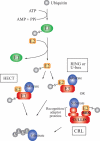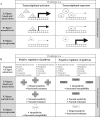Ubiquitin, hormones and biotic stress in plants
- PMID: 17220175
- PMCID: PMC2802907
- DOI: 10.1093/aob/mcl255
Ubiquitin, hormones and biotic stress in plants
Abstract
Background: The covalent attachment of ubiquitin to a substrate protein changes its fate. Notably, proteins typically tagged with a lysine48-linked polyubiquitin chain become substrates for degradation by the 26S proteasome. In recent years many experiments have been performed to characterize the proteins involved in the ubiquitylation process and to identify their substrates, in order to understand better the mechanisms that link specific protein degradation events to regulation of plant growth and development.
Scope: This review focuses on the role that ubiquitin plays in hormone synthesis, hormonal signalling cascades and plant defence mechanisms. Several examples are given of how targeted degradation of proteins affects downstream transcriptional regulation of hormone-responsive genes in the auxin, gibberellin, abscisic acid, ethylene and jasmonate signalling pathways. Additional experiments suggest that ubiquitin-mediated proteolysis may also act upstream of the hormonal signalling cascades by regulating hormone biosynthesis, transport and perception. Moreover, several experiments demonstrate that hormonal cross-talk can occur at the level of proteolysis. The more recently established role of the ubiquitin/proteasome system (UPS) in defence against biotic threats is also reviewed.
Conclusions: The UPS has been implicated in the regulation of almost every developmental process in plants, from embryogenesis to floral organ production probably through its central role in many hormone pathways. More recent evidence provides molecular mechanisms for hormonal cross-talk and links the UPS system to biotic defence responses.
Figures


Similar articles
-
The ubiquitin-proteasome system as a transcriptional regulator of plant immunity.J Exp Bot. 2018 Aug 31;69(19):4529-4537. doi: 10.1093/jxb/ery216. J Exp Bot. 2018. PMID: 29873762
-
Plant ubiquitin-proteasome pathway and its role in gibberellin signaling.Cell Res. 2011 Sep;21(9):1286-94. doi: 10.1038/cr.2011.118. Epub 2011 Jul 26. Cell Res. 2011. PMID: 21788985 Free PMC article. Review.
-
The ubiquitin-26S proteasome system at the nexus of plant biology.Nat Rev Mol Cell Biol. 2009 Jun;10(6):385-97. doi: 10.1038/nrm2688. Epub 2009 May 8. Nat Rev Mol Cell Biol. 2009. PMID: 19424292 Review.
-
The ubiquitin-proteasome system regulates plant hormone signaling.Plant J. 2010 Mar;61(6):1029-40. doi: 10.1111/j.1365-313X.2010.04112.x. Plant J. 2010. PMID: 20409276 Free PMC article. Review.
-
Roles of F-box proteins in plant hormone responses.Acta Biochim Biophys Sin (Shanghai). 2007 Dec;39(12):915-22. doi: 10.1111/j.1745-7270.2007.00358.x. Acta Biochim Biophys Sin (Shanghai). 2007. PMID: 18064383 Review.
Cited by
-
Zebra chip disease decreases tuber (Solanum tuberosum L.) protein content by attenuating protease inhibitor levels and increasing protease activities.Planta. 2015 Nov;242(5):1153-66. doi: 10.1007/s00425-015-2346-9. Epub 2015 Jun 20. Planta. 2015. PMID: 26092706
-
U-box E3 ubiquitin ligase PUB17 acts in the nucleus to promote specific immune pathways triggered by Phytophthora infestans.J Exp Bot. 2015 Jun;66(11):3189-99. doi: 10.1093/jxb/erv128. Epub 2015 Apr 6. J Exp Bot. 2015. PMID: 25873665 Free PMC article.
-
Plasma membrane H(+)-ATPase is involved in methyl jasmonate-induced root hair formation in lettuce (Lactuca sativa L.) seedlings.Plant Cell Rep. 2015 Jun;34(6):1025-36. doi: 10.1007/s00299-015-1762-4. Epub 2015 Feb 17. Plant Cell Rep. 2015. PMID: 25686579
-
Ubiquitin and plant viruses, let's play together!Plant Physiol. 2012 Sep;160(1):72-82. doi: 10.1104/pp.112.201905. Epub 2012 Jul 16. Plant Physiol. 2012. PMID: 22802610 Free PMC article. Review. No abstract available.
-
Next-generation sequencing (NGS) transcriptomes reveal association of multiple genes and pathways contributing to secondary metabolites accumulation in tuberous roots of Aconitum heterophyllum Wall.Planta. 2015 Jul;242(1):239-58. doi: 10.1007/s00425-015-2304-6. Epub 2015 Apr 24. Planta. 2015. PMID: 25904478
References
-
- Abas L, Benjamins R, Malenica N, Paciorek T, Wisniewska J, Moulinier-Anzola JC, et al. Intracellular trafficking and proteolysis of the Arabidopsis auxin-efflux facilitator PIN2 are involved in root gravitropism. Nature Cell Biology. 2006;8:249–256. - PubMed
-
- Achard P, Cheng H, De Grauwe L, Decat J, Schoutteten H, Moritz T, et al. Integration of plant responses to environmentally activated phytohormonal signals. Science. 2006;311:91–94. - PubMed
-
- Alonso JM, Stepanova AN. The ethylene signaling pathway. Science. 2004;306:1513–1515. - PubMed

